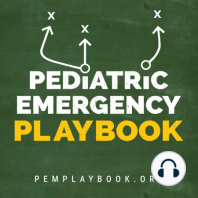36 min listen
Diarrhea
ratings:
Length:
51 minutes
Released:
Jul 1, 2020
Format:
Podcast episode
Description
Traditional Approach: Secretory -- poisoned mucosal villi -- "the sieve" Cytotoxic -- destroyed mucosal villi -- "the shred" Osmotic -- malabsorption -- "the pull" Inflammatory -- edema, motility -- "the push" Lots of overlap, difficult to apply to clinical signs and symptoms. Bedside Approach: Fever/No Fever, Bloody/No Blood Non-bloody, febrile -- most likely viral Non-bloody, afebrile -- may be viral Bloody, febrile -- likely bacterial Non-bloody, afebrile -- full stop. Eval for Hemolytic Uremic Syndrome Workup Ask yourself -- again -- why is this not... appendicitis-torsion-intussusception-etc. Admit sick children, but most go home, so... Non-bloody, febrile -- no workup necessary; precautionary advice Non-bloody, afebrile -- be more skeptical, but generally same as above Bloody, febrile -- stool culture, follow up; do not treat empirically unless septic and admitted. Culture will dictate treat/no treat/how. Bloody, afebrile -- evaluate for hemolytic uremic syndrome, especially if under 5 years old: CBC, chemistries, UA, stool culture Evaluate Hydration Status Selected References Khan WA et al. Central Nervous System Manifestations of Childhood Shigellosis: Prevalence, Risk Factors, and Outcome. Pediatrics. 1999 Feb;103(2):E18 Lee JY et al. Diagnostic yield of stool culture and predictive factors for positive culture in patients with diarrheal illness. Medicine (Baltimore). 2017 Jul; 96(30): e7641. Nelson JD et al. Treatment of Salmonella gastroenteritis with ampicillin, amoxicillin, or placebo. Pediatrics 1980; 65:1125.
Released:
Jul 1, 2020
Format:
Podcast episode
Titles in the series (100)
The Technologically Dependent Child in the ED: EMS is bringing you a child with a VP shunt, port-a-cath, trached on a vent, seizing, hypotensive, and now desaturating – ETA – 3 minutes. Are you ready? Medicine is evolving. As technology advances, we need to meet the challenge of... by Pediatric Emergency Playbook
